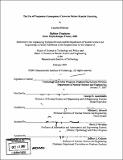The use for frequency-consequence curves in future reactor licensing
Author(s)
Debesse, Laurène
DownloadFull printable version (6.308Mb)
Other Contributors
Massachusetts Institute of Technology. Technology and Policy Program.
Advisor
George A. Apostolakis.
Terms of use
Metadata
Show full item recordAbstract
The licensing of nuclear power plants has focused until now on Light Water Reactors and has not incorporated systematically insights and benefits from Probabilistic Risk Assessment (PRA). With the goal of making the licensing process more efficient, predictable and stable for advanced reactors, the U.S. Nuclear Regulatory Commission (USNRC) has recently drafted a risk-informed and technology-neutral framework for new plant licensing. The Commission expects that advanced nuclear power plants will show enhanced margins of safety, and that advanced reactor designs will comply with the Commission's Safety Goal Policy Statement. In order to meet these expectations, PRA tools are currently being considered; among them are frequency-consequence (F-C) curves, which plot the frequency of having C or more consequences (fatalities, injuries, dollars, dose...) against the consequences C. The present research analyzes the role and the usefulness of such curves in risk-informing the licensing process in the U.S., and shows that their use allows the implementation of both structuralist and rationalist Defense-In-Depth. The second part of this work concentrates on F-C curves as a mean to assess and limit societal risk. Such tools would improve the safety of current plants by allowing the regulator to focus its attention on the plants that pose the highest societal risks in events such as power uprates.
Description
Thesis (S.M.)--Massachusetts Institute of Technology, Dept. of Nuclear Science and Engineering; and, (S.M.)--Massachusetts Institute of Technology, Engineering Systems Division, Technology and Policy Program, 2007. Includes bibliographical references (p. 103-106).
Date issued
2007Department
Massachusetts Institute of Technology. Department of Nuclear Science and Engineering; Massachusetts Institute of Technology. Engineering Systems Division; Technology and Policy ProgramPublisher
Massachusetts Institute of Technology
Keywords
Nuclear Science and Engineering., Technology and Policy Program.
